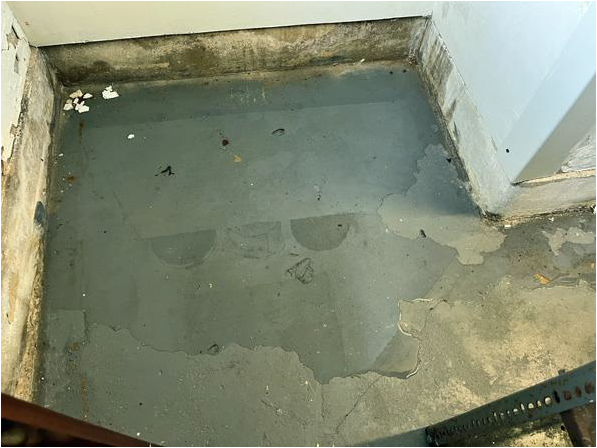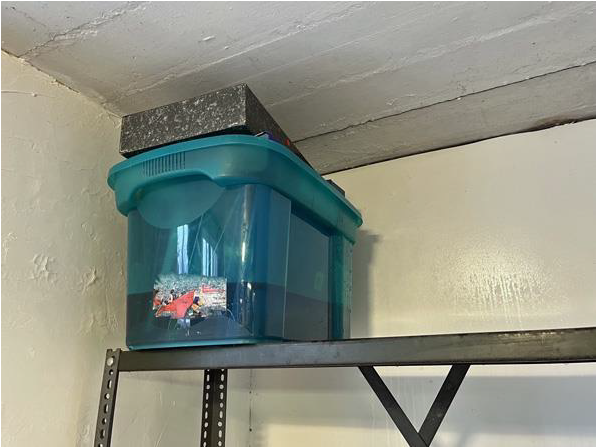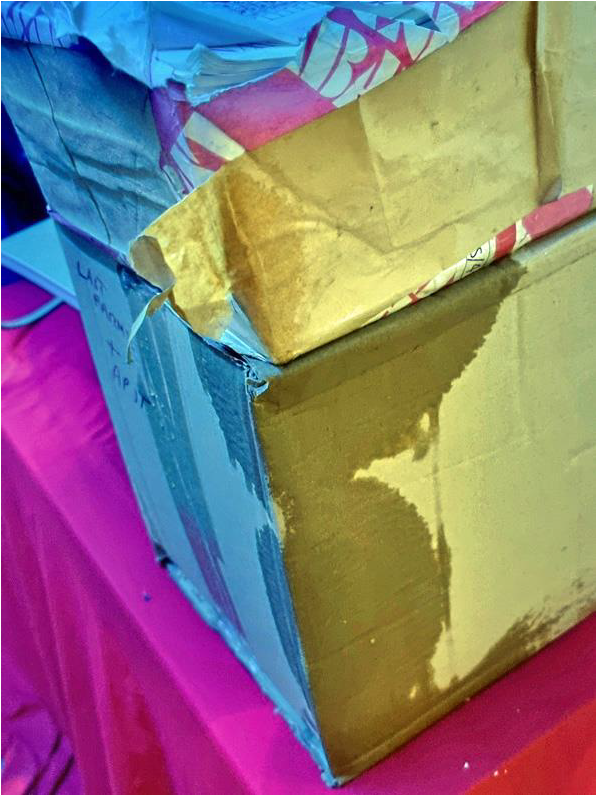
No. 624 March 2023 Edited by Deirdre Barrie
HADAS DIARY – Forthcoming Lectures and Events
We are pleased that we are able to resume lectures face-to-face following Covid, though lectures in winter may be on Zoom. Lectures are held in the Drawing Room, Avenue House, 17 East End Road, Finchley N3 3QE. 7.45 for 8pm. Tea/Coffee/biscuits available for purchase after each talk.
Buses 82, 143, 125, 326 and 460 pass close by, and it is a five to ten-minute walk from Finchley Central Station on the Barnet Branch of the Northern Line. Bus 382 also passes close to Finchley Central Station.
Tuesday 14th March 2023 Robin Densem (HADAS) A Career in Ruins –
Robin’s career in Archaeology.
Tuesday 11th April 2023 Robert Stephenson (Also with CoLAS) – The Thames:
Its Myths and Mysteries
Tuesday 9th May 2023 Bill Bass – Hopscotch in High Barnet: a HADAS dig
Several of us worked on this short but enjoyable ‘backyard’ dig last year, directed by Bill, and the report is being serialised in the newsletter.
Tuesday 13th June 2023 HADAS Annual General Meeting
Followed by a lecture
Membership Renewals
It’s that time of the year again! However, HADAS have not increased their subscriptions again this year, therefore the amounts are: Full member £15, Additional member at the same address £5, Corporate member £15, under 18 or student under 25 in full time education £6.
The HADAS membership year runs from 1st April to 31st March, and so this is to remind all members who pay by cheque that their renewal subscription will be due on or soon after 31st March 2023.
With the closure of many banks, it is helpful if payment is made by Bank Transfer using Account Number 00083254, Sort Code 40-52-40 (CAFBANK). Please include your surname and first initial in the reference field.
If you do need to pay by cheque, please post it to Don Cooper, Hadas, c/o Avenue House, 17 East End Road, Finchley N3 3QE.
Members who pay their subscription by standing order need take no action.
Following Steve Brunning’s untimely death in January 2023, there may be queries about membership issues, please address them to Don Cooper:
1
By email to chairman@hadas.org.uk or olddormouse@hotmail.com
By letter to Don Cooper, 59 Potters Road, Barnet, Herts EN5 5HS
By phone to 020 84404350 or 07802763285
We look forward to receiving your continued membership and thank you for supporting HADAS in its objectives.
Obituary – Edward Harris
We have received a letter from Mrs Valerie Harris informing us that her husband Edward Harris has died. Mr & Mrs Harris have been members since 2009.
Mrs Harris says in her letter “we have had a lot of pleasure from attending meetings and thank everyone for their welcoming kindness”
On behalf of the committee and members of HADAS we express our condolences to Valerie and members of their family.
The Dorothy Newbury Memorial Lecture Jim Nelhams
Although a relatively recent introduction to the Hadas calendar, this is intended as a special event in our year. Most appropriate therefore that it should be the first face-to-face lecture since lockdown. Those attending clearly appreciated being able to meet up not just for the lecture but also the tea and coffee that followed. What a splendid lecture it was!!!
The speaker was Signe Hoffos, a member of the Colas committee (as is our April speaker) who spoke on “Bombed Churches of the City”.
Bombing first happened in the 1914-1918 war, starting with airship raids on Great Yarmouth in January 1915, followed by Stoke Newington in May. The first London air raid by bombers was in June 1917. The development of airships largely stopped following the Hindenburg disaster in 1937 but aircraft development continued into WW2 (during which unmanned machines, the V1 and V2, appeared) and beyond.
In parallel ran the development of bombs. The first ones were small and dropped by hand. These could be incendiary or explosive. As bombers improved, they could carry heavier loads, dropped mechanically. In the City, much of the damage came from incendiaries, which also caused fires identifying target areas for following bombers.
The first WW2 raid on London was on 24th August 1940, with the Blitz running from 7th September to 21st May 1941 during which time, there were 71 raids on London. Signe gave a detailed timeline of the raids which occurred on 29th December 1940 which caused much damage with comparatively little loss of life. As with the 1666 Great Fire of London, this was in the holiday season, but also the Thames was at low tide and the Fire Services were unable to draw much water from the River.
There are now 40 functional churches within the City, many of which were damaged by fire and needed restoration. Signe listed the details. In 1666, there had been around 110, and the remains of some of these were demolished after WW2, being surplice to requirements and in some cases beyond repair.
HADAS Excavation at ‘Hopscotch’ 88 High St, Barnet EN5 5SN
(Part 3 the finds – glass, Tim Curtis, Janet Mortimer and Andy Simpson.)
Site code OPS22
Glass Report
A variety of utilitarian glass food and both alcoholic and non-alcoholic drink containers were found, mostly in fragmentary form, with some drinking vessel pieces and some window glass and a number of
2
unidentifiable fragments, but seemingly not much in the way of ‘decorative’ domestic glassware. Most appears to be of twentieth century date, with a small number of earlier fragments.
Context 001
There were five complete vessels from this context – four bottles and one jar.
One Pint milk bottle, probable 1930s date, of clear glass with relief moulded ‘A1’ Dairies, base moulded ‘A1’ and UGB (United Glass Bottle) machine mark of 1913-1968. Has a distinctive wide neck for a card stopper. This former company had local links, being based at 1411 High Road, Whetstone by 1920 until at least the late 1960s. (There is also the broken base of a half-pint A1 Dairies bottle).
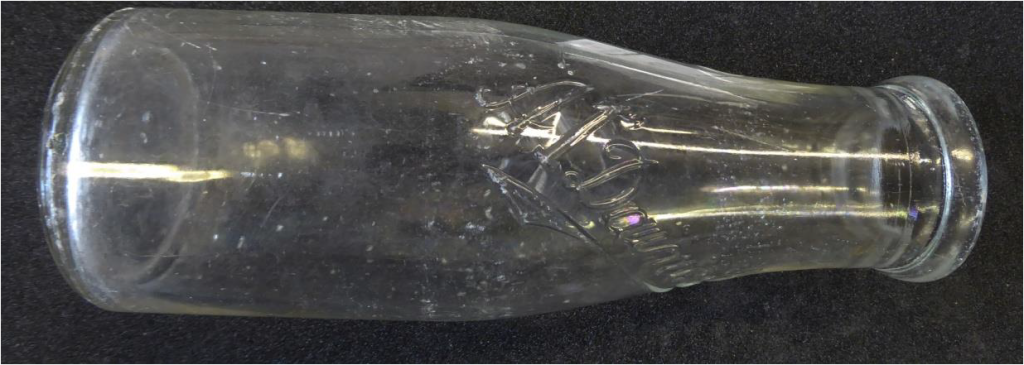
Half Pint brown glass beer bottle, post-1892 crown cork bottle cap rim, with no identification marks. Machine-moulded seams running across the rim (pictured below).
Small brown glass cylindrical bottle with external screw threaded rim. No identification marks, UGB makers’ mark (post 1913) and machine-made mould mark running across the rim.
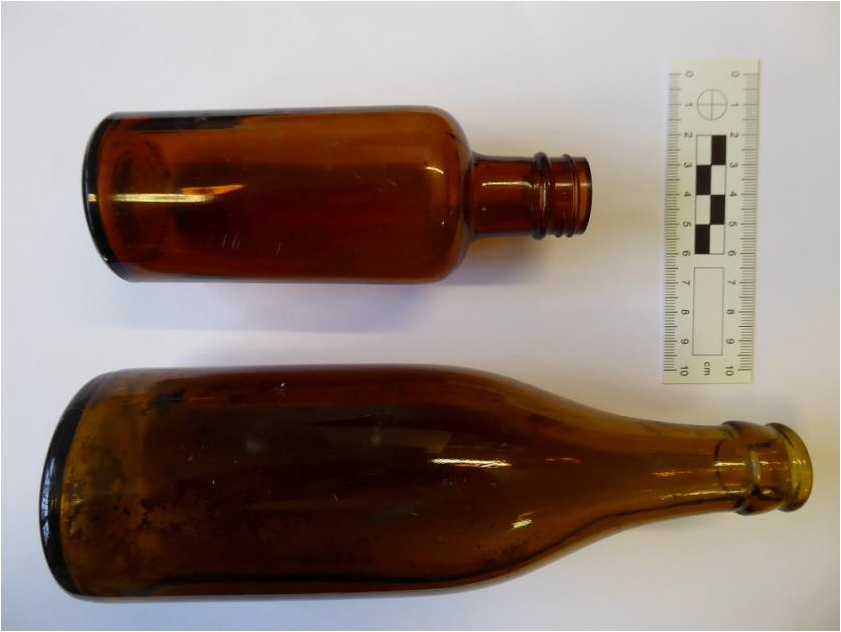
Small clear glass cylindrical bottle with external screw threaded rim. No identification marks. Machine mould running across the rim.
Squat clear glass ramekin canning style food jar, machine made, with no identification marks.
Other Bottles
A variety of bottle shapes were recovered, mostly in clear glass but with some green and brown bottle glass also.
They include one post-1872 Codd-neck bottle rim lip, familiar to older readers as ‘marble bottles’ comparable to a complete example owned by co-author Tim Curtis, plus a fragment of base and side,
3
possibly also from a Codd bottle, marked ‘’’ATE & CO… ARM moulded into bottle side and ‘12’ on base bottom (pictured below).
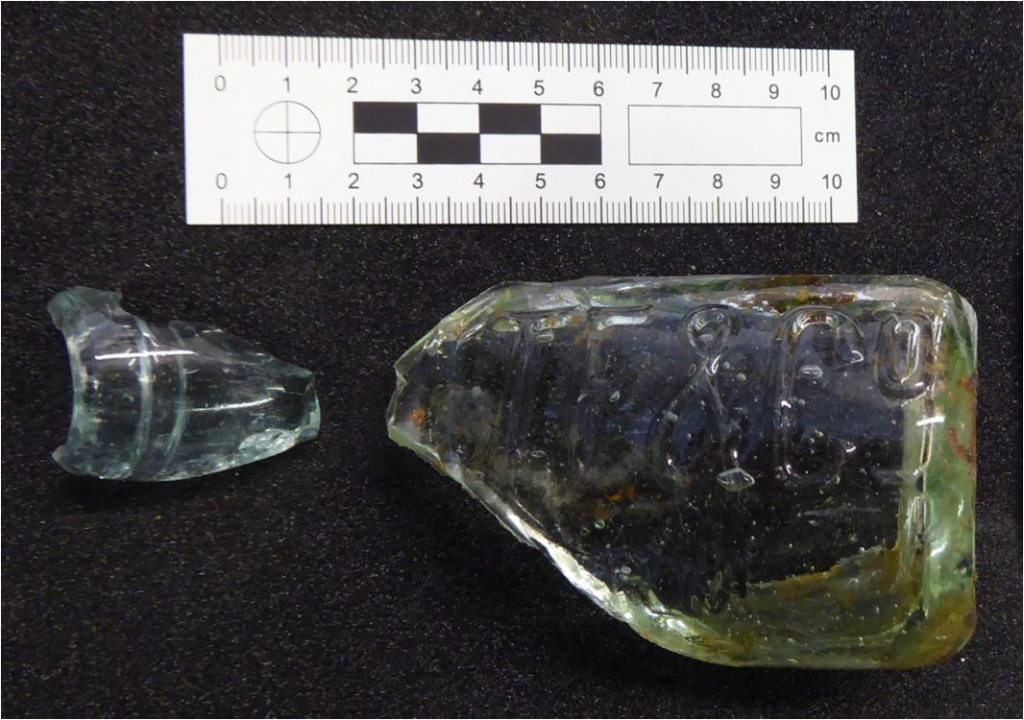
Green bottle glass frags include a well broken up but part reconstructed ‘rich green’ soft drink bottle, probably lemonade, marked ‘BANKS OF DEPTFORD’ with ‘1/4D DEPOSIT CHARGE ON THIS BOTTLE’ in relief moulded lettering (pictured below x2).
George Banks of Church Street, Deptford in South-East London also produced ginger beer sold in stoneware bottles by the 1890s.
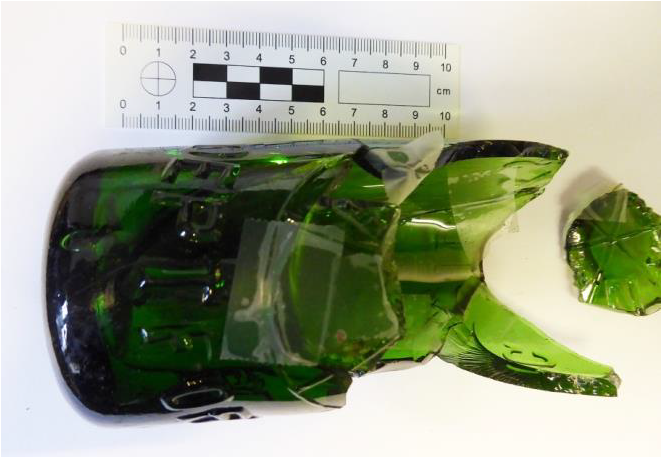
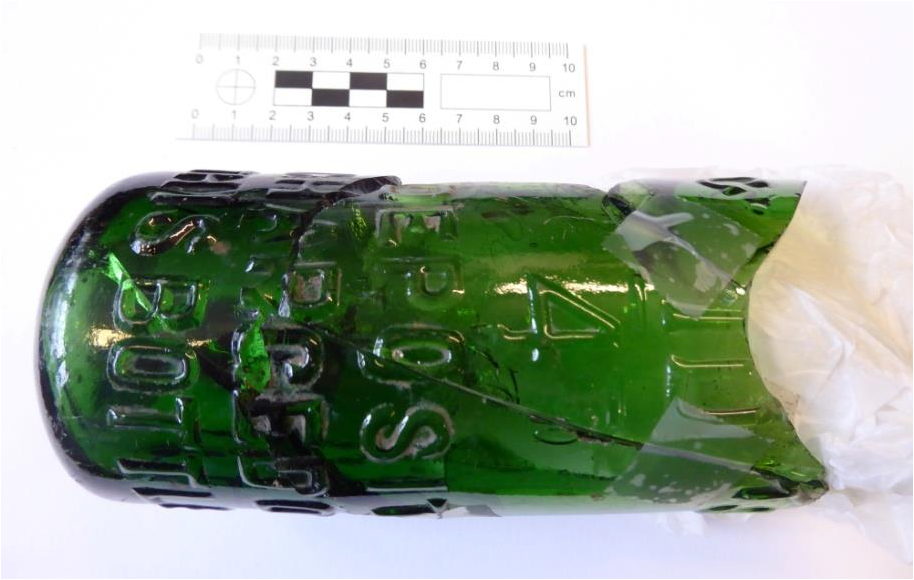
4
There are further fragments of body and base of a similar bottle of ‘R. WHITE’ also with ‘1/4D DEPOSIT CHARGED referring to the one farthing charge on each bottle. This Camberwell, South London-based company, R.White & Sons Ltd, started to charge the farthing deposit from the 1890s to encourage the return and reuse of its bottles.
There are other green glass fragments which may be parts of those above, but we cannot be certain.
They include three quite substantial and weighty internal screw thread top/neck fragments, bagged separately by slight differences in the shade of green of the glass, plus a further fragment of 1/4D deposit from a likely further bottle. There is also a miscellaneous green base fragment with part sides and an interesting internal dome, being notably thick walled with an unstable base. Additionally, there are five fragments, four cojoining, of a thin-walled cylindrical bottle with external screw thread rim.
Brown bottle glass fragment: there is one fragment of bottle neck with external screw thread and two seemingly associated fragments of ferrous threaded bottle cap.
Clear bottle glass: there is a selection of bases from six other anonymous cylindrical bottles, one with an interesting ‘TVT’ base mark and another with the familiar ‘UGB’, and one-part base with registered number on base ‘792625’
.
One particularly nice item is a glass stopper, possibly for a sauce bottle, such as Lee & Perrins Worcester Sauce or HP Sauce.
There is a single fragment of the ribbed side with ‘S’ of the maker’s name of a distinctive Chichester-based Shippam’s Paste jar, introduced by that company from 1906 with airtight metal caps. An interesting (and appropriate, given the shop at the front of the site) group is the ‘BOTT SQ 1’ square glass bottle or jar fragments, including eight body and rim fragments from one large square vessel with rounded corners, possibly an old-style sweet display jar, and two large co-joining body fragments also with rounded corners, possibly part of the vessel first described.
Nearby leisure drinking is indicated by the bases of two substantial vessels with notably deep and heavy weighted bases, identified as tumblers.
A variety of fragments of further GLASS JARS were found, consisting of one base and eight rims, including two heavy externally threaded rim fragments and two collared rims.
A number of fragments were too small too definitively identify as to vessel type;
There are three fragments of green bottle glass with surface patina, two of them base fragments with a notably pronounced kick up, possibly of nineteenth century date. Also two heavy dark green fragments, one a shoulder fragment of a large bottle embossed with the word ‘PROPERTY’ the other ‘-KO-‘ plus seven miscellaneous fragments of green and brown glass, probably bottle glass.
There are also 34 miscellaneous clear glass body sherds from bottles and a wine glass.
Several varieties of window glass were found, 37 fragments in all, of four different thicknesses between 1-7mm, including clear glass, 15 frosted/obscured glass fragments, some with a distinctive ‘star’ design and others with a triangular raised facet design, and four pieces which joined, identified as possibly being from a table-top.
Context 002
Yielded just two small body sherds of green glass, probably 19th century in date. One was from a cylindrical bottle, possibly wine, probably mould blown with bubbles and an irregular surface. The other
5
had an irregularly shaped profile and was possibly part of a mineral water bottle, of patent shape, possibly Codd patent of 1872.
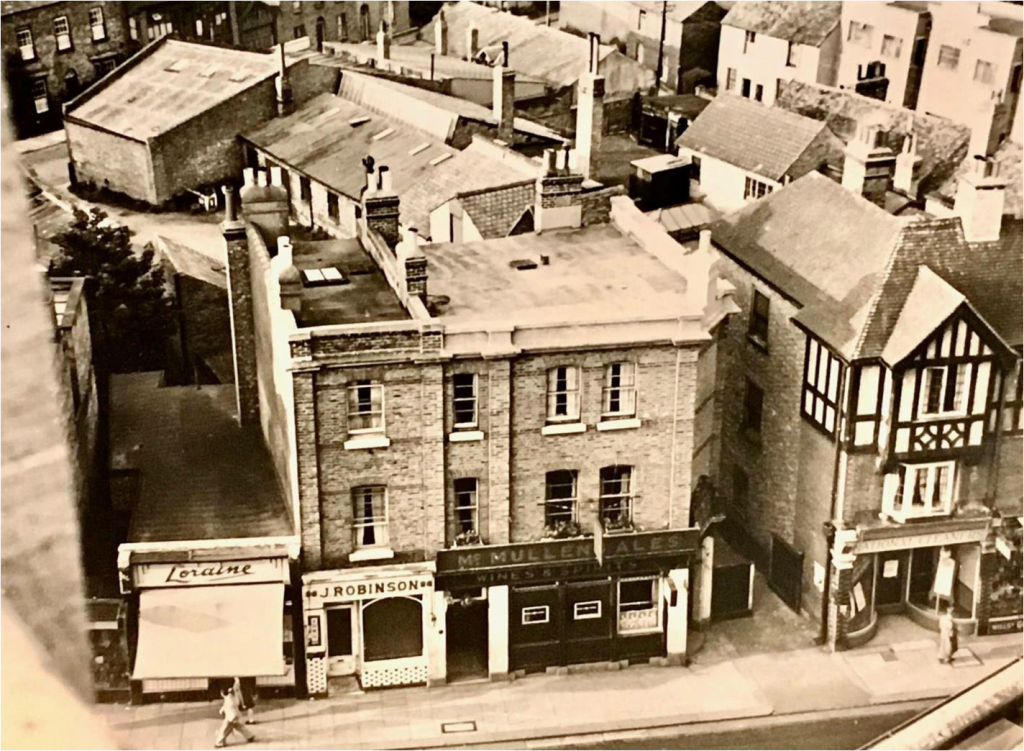
6
had an irregularly shaped profile and was possibly part of a mineral water bottle, of patent shape, possibly Codd patent of 1872.
Hopscotch in one of its previous incarnations as ‘Loraine’ in the 1950s or 60s – this shows the nearby ‘King’s Head’ McMullens pub and other establishments which could have generated the dumping of glass and other materials in the back yards. The tree (now gone) at the back of ‘Loraine’ was the site of our dig and caused a few problems with soil disturbance.
Flooding in the basement Don Cooper
Following torrential rain and falling leaves on the weekend of 5th November, the HADAS Sunday Morning group arrived to find water flowing down the wall nearest the window in the basement creating a small lake on the floor. The storage unit in that corner contained some of our new books store. Note the amount of water in the storage box in the photo below.
6
Fortunately, although the cardboard boxes in which the books were stored, were destroyed, only about 38 books were damaged.
Once we had mopped up and removed the racking it was clear that there was black mould on the wall. It must have happened before!
The cause appears to be heavy rain on the flat roof, a blocked hopper (probably incorrectly sited anyway) and autumn leaves. When informed Avenue House said a builder was coming.
7
As a result, we are replacing the cardboard boxes with secure plastic ones, relocating the books and in the meantime, we are clearing the drains and downpipe hoppers. We are writing to Avenue House for them to take action on the mould and redecorating the space.
Thanks to all who helped to clear up and supplied the photos.
BOOK AND MAGAZINE REVIEWS Andy Simpson
Dr Henry Hicks (1837-99) The Life and Times of Dr Henry Hicks of St David’s, and the Bubble that refused to Burst.
Published by Y Lolfa Cyf 2023 Softback, portrait format. 105x212mm, 24 colour and monochrome images. ISBN 978-1-80099-331-0.
Available from the publisher – www.ylolfa.com
HADAS occasionally get sent newly-published books; some are of direct relevance to local history; some, like this slim but readable 42-page volume received in January 2023, contain unexpected gems relevant to our local history.
Welsh born and speaking, the energetic Dr Henry Hicks MD, MRCS, FRS was a GP, chemist, amateur archaeologist and renowned and widely respected amateur geologist, who was at one time President of the Geological Society of London. Though dying in Hendon relatively young aged 62 years on 18 November 1899, he left a legacy in UK geological research and many publications. He lived and practised in Hendon for nearly three decades from early 1871, and is buried in Hendon St Mary’s church-yard, although his gravestone is now lost. However, he is remembered on a plaque inside the church.
He was a long-time resident of the long-lost Grove House – which stood in extensive grounds to the north of the Burroughs. Grove House (otherwise known as Hendon Grove or The Grove) was a large stuccoed two-story building built by 1753 and shown, un-named, on Crow’s 1754 map, and was originally owned by John Cross and Mrs. Marsh jointly, being sited to give commanding views westwards towards Harrow and north to Mill Hill. By 1796 Cooke recorded it having ‘coach-house, stabling, out office, yards, garden etc. with road leading to the same.’
‘The Metropolitan Convalescent Institution’ accommodated 40 young girls at Burroughs House c. 1874. It was substantially rebuilt in the 19th century by a Mrs. Campbell, who in turn leased it to Dr Hicks who ran it as ‘Hendon Grove Asylum’ – a private nursing home, from February 1879 to 1898. By 1881 it was caring for 12 mentally-ill female patients and was home to Dr Hicks, his wife, three daughters and staff. He was greatly active in local affairs and by 1888 Chairman of the Hendon Drainage Committee.
Grove House later continued as a mental home run by Dr Edridge-Green.
It was demolished in 1934, following purchase by Hendon Council. The now-levelled site of the house and part of its grounds survive as a small public park called The Grove at the rear of the Fire Station and University, with the original entrance avenue off the Burroughs which led directly to the house. The entrance is still extant between University buildings and now leads to the park and site of the house.
8
As originally reported in the ‘Proceedings of the Society of Antiquaries’ for 5th December 1889, page 16, and the ‘Hendon and District Times’ of 13 December 1889, the earliest recorded find of Roman material in the Hendon area is that from the former Grove House.
At a point 730ft W.S.W of the church and 300ft north of Grove House, during the digging of a gravel pit its then occupant, the St. David’s, Pembrokeshire-born Dr. Hicks found bone fragments, flanged roofing tile, brick, millstones, a complete 19 cm high ring-necked single-handled flagon of second century date (see below) and other fragments of mortaria food mixing bowls, water jugs and other pottery, including ‘broken cinerary urns’ all scattered about in the soil a foot below the surface, mostly in a ‘well defined longitudinal excavation’ some ten feet long, and extending down for about 18 inches into the undisturbed sand below.
Dr Hicks had previously excavated prehistoric sites in the St. David’s area.
The approximate OS ref is TQ 2270 8940, SMR/HER 081913-01, 02. Whether in a Roman pit or even a burial is not now clear. (See Robertson, B 1973, ‘Roman Material Found at Grove House, Hendon, in 1889.’ Transactions of The London And Middlesex Archaeological Society 24, 146-150)
Four pieces of this material reportedly survived in the Barnet local history collection, including two pieces of brick, one of them, most interestingly, a section of circular brick of the ‘bessalis’ type used in hypocausts, sculpture bases or to build small diameter columns which would be faced with moulded
cement and painted plaster; the surviving material is considered to be of late first or second century date,
and includes the single-handled Roman flagon of c.175-250 A.D, presented by Dr F.H.K Green, a relative
of Dr Hicks, in March 1949, as were the two brick fragments, and a small, cased fragment of 133 plain buff tesserae tessellated pavement believed to have also been found at the Grove, though this is disputed, as there is no evidence to link it to the Grove House finds, since it was not listed with them at the time. Supposedly found in Hendon prior to 1890, it was donated in December 1948 by Miss N.F.Waters and looks more like a collectors’ item from elsewhere.
In 2011, the pavement fragment at least remained in store at the now-closed and much-lamented Church Farm Museum, and passed to the care of HADAS in May 2012, with whom it remains, with original paper label on the rear recording accession no A61 ‘Fragment of Roman pavement believed to be part of a collection excavated at Hendon Grove in 1889 Don 3124 Mrs. N F Waters’;
The other Grove House fragments and three other fragments of Roman pottery, possibly from the same site, have not been seen since at least 2011, since Church Farm Museum records were incomplete and the items could not be positively identified when it closed.
And the Bubble that Refused to Burst? That was Dr Hicks and his contentious identification and dating of rocks of the Llyn Peninsula and Western Isles of Scotland.
The High Barnet Branch by Peter Kay, published in London Railway Record Number 114, January 2023. Portrait format, 113x210mm. Numerous colour and monochrome images. ISSN 1355-8013. £4.50.
HADAS of course has a number of railway enthusiast members, and several of us already regularly purchase this particular quarterly magazine, which has proved an invaluable source since first published in 1994. Although it covers the whole of London, past and present, concentrating in particular on stations and infrastructure rather than the usual locomotives and rolling stock, the Barnet Borough area regularly appears in coverage of the Midland Main Line via Hendon and the East Coast Main Line via East Barnet, along with the interconnecting tube lines and secondary lines.
9
Editor and Publisher Peter Kay has just started what would appear to be the first of several articles covering the former Great Northern/London and North Eastern Railway suburban branch lines from High Barnet, Edgware and Alexandra Palace via Finchley and Highgate to Finsbury Park, parts of which now form the Barnet and Mill Hill East Branches of the Northern Line, or leafy walks to Edgware and Alexandra Palace.
The Barnet Branch opened in 1872 and hosted regular steam-, and later diesel-hauled ‘main line’ freight trains to High Barnet until 1962 (which also ran to Edgware until the spring of 1964). This first article features Victorian/Edwardian and later photographs and detailed plans of the stations at High Barnet, Totteridge, Woodside Park, and West Finchley.
The extended photo captions and detailed text cover historical and operational matters, including an 1870s developer trying unsuccessfully to have Woodside Park, then named ‘Torrington Park, Woodside’ renamed ‘Belgravia Park’ as propaganda for his development.
This excellent magazine is always worth a look, even for those without a particular railway interest, given the breadth of its local history coverage, and is normally available from the London Transport Museum shop at Covent Garden, and local transport collectors’ fairs at Borehamwood, Enfield and Chiswick, as well as by subscription. Further details from www.londonrailwayrecord.co.uk
Other Societies’ Events Eric Morgan
Not all Societies or Organisations have yet returned to pre-covid conditions. Please check with them before planning to attend.
Thursday, 16th March, 7.30 p.m. Camden History Society. Talk on Zoom. Ship of Lost Ambitions: The ‘Titanic’ Connections with Camden, by Kevin Brown. Please visit www.camdenhistorysociety.org for details.
Friday 17th March, 7.30 p.m. Wembley History Society, St. Andrew’s Church Hall (behind St. Andrew’s New Church) Church Lane, Kingsbury, NW9. (Please note new venue). Time and Tide, Treasure and Trash: A Mudlark’s Searches for London’s History. Talk by Monika Bettling-Smith. Visitors £3. Refreshments in interval.
Monday 20th March, 8p.m. Enfield Society, Jubilee Hall, 2, Parsonage Lane/junction Chase Side, Enfield EN2 0AJ. The World of Art Nouveau. Talk by Mark Lewis on its origins, the key exponents of the movement and its eventual demise.
Tuesday 4th April, 8p.m. Historical Association, North London Branch. Jubilee Hall (address as above). Beyond The Seas and Return: The English Catholic Cross-Channel Community in the 17th C. Talk by Dr. Liesbeth Corens (Queen Mary, University of London).
Tuesday 11th April, 6.30 p.m. LAMAS. Talk on Zoom. Syon Abbey Revisited: Reconstructing Late Medieval England’s Wealthiest Nunnery. Talk by Bob Cowie (MOLA). Please book via www.lamas.org/lectures.html.
Wednesday 12th April, 8p.m. Hornsey Historical Society Talk on Zoom. Wartime London in Paintings. Speaker TBA. Please e-mail hornseyhistoricalchairman@gmail.com for link. Also visit www.hornseyhistorical.org.uk.
Saturday 15th April, 11a.m.-2.30p.m. North London and Essex Transport. Enfield Transport Bazaar. St. Stephen’s Church Hall, Village Road, Enfield EN1 2EY. Lots of stalls selling books, photos, DVDs, maps, models, timetables, tickets and other memorabilia. Refreshments available. Admission £3.
10
Monday 17th April, 3p.m. Barnet Museum and Local History Society, St. John the Baptist Church, Chipping Barnet, corner of High St./Wood St, Barnet, EN5 4BW. Enfield: The Other Royal Palace. Talk by Ian Jones (Chair, Enfield Archaeological Society) Please visit www.barnetmuseum.co.uk
Tuesday 18th April, 7.30p.m. Camden History Society. Talk, hopefully on Zoom: The Bombing of London,1940-41: The Blitz and its Impact on the Capital talk by John Conen. Please visit www.camdenhistorysociety.org for details.
Tuesday 18th April, 8p.m. Ruislip, Northwood and Eastcote Local History Society. Talk should be on Zoom. Northolt Park Racecourse (1929-40) by Colin Richards. Please see www.RNELHS.org.uk.
Wednesday 19th April, 7.30 p.m. Enfield Society, joint with Edmonton Hundred Historical Society. All Saints Church Hall, Church Street, Edmonton N9 9AT. (Please note different venue). Thirty Years at the Edmonton Charity Girls’ School. Talk by Irene Money. Free.
Thursday 20th April, 8p.m. Historical Association: Hampstead and NW London Branch. Ancient Sumeria and its Modern Legacy. Talk by Karin Doll. Will present hypotheses on where key developments in civilisation began including writing, the wheel, plough, bricks and irrigation, and mathematical and writing systems 5,000 years ago. Meet at Fellowship House, 136a, Willifield Way, London NW11 6YD (off Finchley Road, Temple Fortune). Hopefully also on Zoom. Please email Jeremy Berkoff (Chair) on jeremyberkoff@mac.com or tel. 07793 229521 for details of Zoom link and how to pay (there may be a voluntary charge of £5). Refreshments after.
Friday 21st April, 8p.m. Richmond Archaeological Society. Talk on Zoom. Surviving in Lower Palaeolithic Europe by Prof Rob Hosfield. For information on how to join, please visit www.richmondarchaeology.org.uk or email richmond.archaeology@gmail.com.
Saturday 22nd April, 11a.m. Willesden Local History Society. Meet at Dissenters’ Chapel, Kensal Green Cemetery (Entrance off the Flower Maiden, Ladbroke Grove, W10) John Passmore Edwards Festival. To mark the bi-centenary of the birth of the philanthropist on the 24th March, 1823 and the anniversary of his death on 22nd April, 1911, including a laying of a wreath on his grave, a tour of the philanthropists buried at the cemetery, presentations about him and his work, an exhibition in the chapel, and refreshments. To join please contact Irina Porter (Chair and Friends of Kensal Green Cemetery Trustee) on irinaporter@outlook.com or tel. 07510 933282 It is free, but donations are welcome. Please book in advance on www.willesden-local-history.co.uk or by email.
Wednesday 26th April, 6 p.m, Gresham College. Finding Lost Gods in Wales. Talk by Ronald Hutton. Ticket required. Register at www.gresham.ac.uk and view on line. Please see Finding Lost Gods in Wales | Gresham College. Free. From the poetry and stories of medieval Wales in such as the ‘Red Book of Hergest’ and the book of Taliesin about pagan gods and goddesses with characters such as Rhiannon, Arianrhod,, the flower maiden Blodeuwedd and Lieu Deunedd
Wednesday 26th April, 7.45p.m, Friern Barnet and District Local History Society. North Middlesex Golf Club, The Manor House, Friern Barnet Lane, N20 ONL. The Great Northern Railway. Talk by Dave Cockle (Enfield Society Chair) Please visit www.friernbarnethistory.org.uk and click on ‘Programme’, or phone 020 8368 8314 for up-to-date details. (David Berger, Chair). Non-members £2. Bar available.
Thursday, 27th April, 7.30p.m. Finchley Society. Drawing room, Avenue (Stephens’) House, 17, East End Road, N3 3QE. H.G. Pelissier: A Famous Son of Finchley. Talk by Anthony Binns and Jaudy Pelissier. For further details please visit www.finchleysociety.org.uk Non-members £2 at the door. Refreshments in interval.
11
++++++++++++++++++++++++++++++++++++++++++++++++++++++++++++++++++++++
With many thanks to this month’s other contributors: Bill Bass, Don Cooper, Tim Curtis,
Eric Morgan, Janet Mortimer, Jim Nelhams and Andy Simpson
++++++++++++++++++++++++++++++++++++++++++++++++++++++++++++++++++++++
Hendon and District Archaeological Society
Chairman Don Cooper, 59, Potters Road, Barnet EN5 5HS (020 8440 4350)
e-mail: chairman@hadas.org.uk
Hon. Secretary Janet Mortimer, 34, Cloister Road, Childs Hill, London NW2 2NP
(07449 978121) e-mail: secretary@hadas.org.uk
Hon. Treasurer Roger Chapman, 50, Summerlee Ave, London N2 9QP
(07855 304488) e-mail: treasurer@hadas.org.uk
Membership Sec Vacancy
While we have no Membership Secretary –
for the present, please address any correspondence such as change of member addresses or other miscellaneous correspondence to:
HADAS, c/o Avenue House, 17 East End Road, Finchley, London N3 3QE
Website at: www.hadas.org.uk – join the HADAS email discussion group via the website.
12

